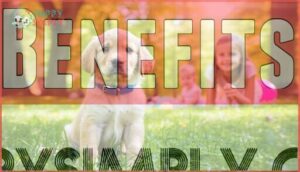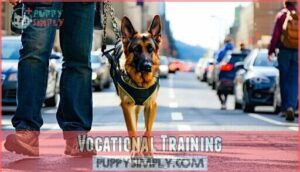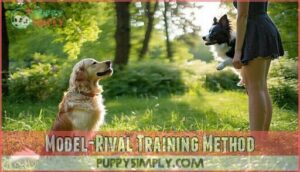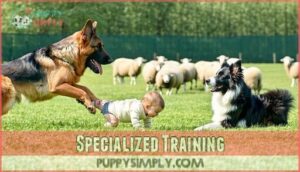This site is supported by our readers. We may earn a commission, at no cost to you, if you purchase through links.
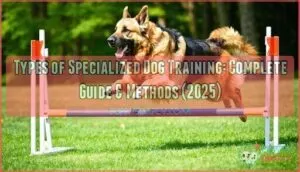
Service dog training prepares dogs to assist people with disabilities, while therapy dog training creates companions for hospitals and schools.
Protection training develops guard dogs for security work, and tracking training teaches dogs to follow scents for search and rescue missions.
Agility training turns your pup into an athletic competitor, traversing obstacles with speed and precision, and Retrieving training perfects hunting skills, making dogs excellent field companions.
Each specialization requires specific techniques and months of dedicated practice, and the right training depends on your dog’s natural abilities and your intended goals—some methods work better than others for different breeds, focusing on basic commands, natural abilities, and dedicated practice to achieve athletic competitor status.
Table Of Contents
- Key Takeaways
- Basic Dog Training Methods
- Obedience Training
- Behavioral Training
- Specialized Training
- Choosing The Right Training Method
- Frequently Asked Questions (FAQs)
- What are the different types of specialized dog training?
- What are the different types of dog training?
- What is a basic dog training?
- How many types of specialized training can a dog undergo?
- Do therapy dogs have specialized training?
- What are the most common dog training approaches?
- What is the most effective type of dog training?
- What is the 3-3-3 rule for dog training?
- What is the 7 7 7 rule for dogs?
- What are the 4 quadrants of dog training?
- Conclusion
Key Takeaways
- You’ll find specialized training goes far beyond basic commands – Service dogs assist people with disabilities, therapy dogs provide emotional support in hospitals and schools, protection dogs handle security work, and agility training creates athletic competitors who navigate obstacle courses with speed and precision.
- Your success depends on matching the training method to your dog’s personality and your goals – Positive reinforcement works well for most dogs through treats and praise, while specialized roles may require hybrid approaches that combine different techniques based on your dog’s natural abilities and temperament.
- You can choose from multiple training paths that require different time commitments – Basic obedience training establishes foundation commands like sit and stay, while specialized programs like service dog training take 1-2 years and tracking or protection training require professional guidance and substantial investment.
- You’ll need to assess your dog’s breed characteristics and natural strengths before selecting specialized training – Golden Retrievers excel in therapy work, German Shepherds thrive in protection roles, and active breeds like Border Collies are ideal for agility training, making breed suitability crucial for successful outcomes.
Basic Dog Training Methods
You’ll encounter three primary methods when training your dog: positive reinforcement that rewards good behavior, e-training that uses electronic collars for corrections, and alpha training that establishes your role as pack leader.
Each method offers different approaches to teaching your dog, and many trainers combine these techniques based on your dog’s personality and specific training goals.
Many trainers also find that alpha training is effective in establishing a clear hierarchy, which can be beneficial for dogs that require a strong leader.
Positive Reinforcement
Positive reinforcement transforms your dog’s learning experience by rewarding good behavior instead of punishing mistakes.
Good behavior earns rewards, bad behavior gets ignored—that’s how dogs learn best.
This reward-based training method uses treats, verbal praise, and toy rewards to encourage desired actions, making dog obedience training enjoyable for both you and your pup.
The beauty of positive reinforcement lies in its flexibility.
You can use different reward schedules, offering treats immediately after good behavior or gradually spacing them out as your dog masters commands.
Lure training works particularly well for teaching new tricks—simply guide your dog into position with a treat, then reward success.
Shaping behavior happens naturally through this approach.
Your dog learns to repeat actions that earn rewards, building confidence with each success.
Dog behavior modification becomes less stressful when you’re celebrating wins rather than correcting failures.
These dog training techniques create lasting bonds between you and your canine companion, establishing trust that makes advanced training easier down the road.
They promote a reward-based approach, focusing on encouraging good behavior rather than punishing bad behavior, which is key to successful dog training.
E-Training
While treats and praise work wonders, some situations call for electronic training collars.
E-training uses controlled stimulation to communicate with your dog at a distance.
Modern e-collars offer vibration, tone, and shock options, making them versatile training tools when used correctly.
The shock level debate continues among trainers, but expert supervision guarantees safe application.
E-collar safety depends on proper fitting and gradual introduction.
Misuse potential exists when owners skip professional guidance or use excessive stimulation levels.
Specialized training programs often incorporate e-training for off-leash reliability and distance commands.
Dog training online lessons and dog training video resources help owners understand proper techniques.
However, alternatives explored include long lines and whistle training before considering electronic options for your specific training goals.
Alpha Training
While e-collars use technology to modify behavior, alpha training takes a completely different approach by focusing on establishing human dominance over your dog. This method stems from outdated wolf pack theories that have been thoroughly debunked by modern animal behavior science.
Alpha training involves actions like eating before your dog, walking through doorways first, and restricting access to furniture or beds. The goal is positioning yourself as the "pack leader" through dominance-based techniques.
However, these Alpha Misconceptions can create serious Training Dangers. Dominance training often leads to fear-based responses rather than genuine obedience. Many dogs become anxious or aggressive when subjected to these methods, creating Ethical Concerns among professional trainers.
Modern research shows that Alternative Methods like positive reinforcement produce better results without the risks. Effective training relies on rewarding desired behaviors to encourage recurrence. Most certified trainers now recommend relationship-based approaches that build trust rather than dominance, making Dominance Debunked practices increasingly obsolete in effective dog training programs.
Obedience Training
You’ll find that obedience training serves as the foundation for all other dog training methods, teaching your dog essential commands like sit, stay, come, and heel that create structure and safety in daily life.
This training approach establishes clear communication between you and your dog, making it easier to address behavioral issues and prepare for more advanced specialized training programs that focus on daily life.
Benefits
Building a well-trained dog transforms your daily life in remarkable ways.
Transform your daily routine with a well-trained companion who brings joy, safety, and deeper connection to every moment.
Dog training benefits include stronger bonds through clear communication and trust-building exercises.
You’ll notice improved safety as your dog responds reliably to commands during walks or emergencies.
Mental stimulation from training sessions keeps your pet engaged and happy.
Specialized training enhances roles for working dogs while increasing confidence in both owner and pet.
These dog training goals create lasting improvements in dog behavior and overall quality of life.
Vocational Training
Vocational training transforms your dog from a beloved pet into a working professional. This specialized approach focuses on skill development that meets specific employer needs and industry standards.
Service dog training requires years of preparation, teaching tasks like mobility assistance and medical alert responses. Therapy dog training emphasizes calm temperament and social skills for hospital visits.
Search and rescue dogs learn scent detection training to locate missing persons in various terrains. Each vocational path demands different certification programs.
Assistance dog training covers guide work for the visually impaired, while scent detection training prepares dogs for law enforcement roles. The key lies in matching your dog’s natural abilities with job placement opportunities.
Golden Retrievers excel in therapy work, while German Shepherds thrive in protection roles. Success depends on consistent training and professional guidance.
Training Methods
By understanding different dog training methods, you’ll discover the perfect approach for your canine companion.
Reward systems using treats and praise form the foundation of most successful techniques.
While aversive techniques exist, relationship focus methods emphasize building trust.
Modern neuroimaging advances reveal how dogs learn, while genomic impact studies show breed-specific training preferences.
Choose canine training methods that match your dog’s personality and learning style.
Behavioral Training
If you’re dealing with problem behaviors like excessive barking, jumping, or aggression, behavioral training targets the root causes of these unwanted actions.
This specialized approach focuses on understanding why your dog acts out and then uses proven techniques to modify those behaviors while strengthening your relationship.
Model-Rival Training Method
Model-rival training taps into your dog’s natural competitive instincts through demonstration learning. This specialized training approach uses observational learning where your pup watches another dog or person perform desired behaviors. Think of it as "monkey see, monkey do" for canines.
This training method leverages cognitive processes that make dogs want to outperform their "rival." Here’s how model-rival training works:
- Choose a well-trained model – Use another dog or human demonstrator
- Create friendly competition – Let your dog observe the model receiving rewards
- Switch roles regularly – Allow your dog to become the successful performer
- Reward immediately – Praise when your dog mimics the behavior
Social learning through imitation training helps dogs understand commands faster than traditional training methods alone.
Relationship-Based Training Method
Relationship-based training transforms your dog’s behavior through trust building and emotional connection.
This dog training philosophy prioritizes mutual respect over dominance, creating a foundation where communication skills flourish naturally.
You’ll use positive reinforcement while reading your dog’s body language, strengthening your bond through shared activities.
This approach makes learning enjoyable for both you and your pup.
When dogs feel secure and understood, they’re more willing to cooperate.
One key is to use high-value food rewards to motivate your dog.
These dog training techniques focus on partnership rather than control, leading to lasting behavioral changes.
Specialized Training
When you’re ready to move beyond basic obedience and behavioral training, specialized training opens up a world of advanced possibilities for your dog.
These focused programs prepare dogs for specific roles like therapy work, service tasks, protection duties, and competitive sports, requiring dedicated time and often professional guidance to achieve success.
Therapy Dog Training
Therapy dog training prepares your canine companion to provide emotional support in hospitals, schools, and nursing homes.
You’ll focus on temperament evaluation and certification process requirements. Your dog must demonstrate calm behavior during facility requirements assessments.
Handler skills development includes recognizing stress signals and managing interactions. These dogs help lower blood pressure and anxiety, as well as increase levels of oxytocin.
Many volunteer opportunities await certified therapy dogs, offering rewarding experiences for both you and your pet.
Service Dog Training
Service dog training transforms exceptional canines into life-changing companions for people with disabilities.
This intensive process develops task-specific skills like mobility assistance, medical alerts, and guide work.
You’ll need dogs with strong breed suitability—typically Labradors or German Shepherds—who can handle public interaction while reducing handler dependence.
The rigorous 1-2 year program requires professional guidance and raises important ethical considerations.
Unlike therapy dog training, service dogs gain legal access rights everywhere.
These dogs perform specific tasks for disabilities.
Protection Training
While service dogs assist with daily tasks, protection training transforms your dog into a reliable guardian.
This specialized training requires professional expertise and substantial investment, typically costing $15,000-$25,000 for complete programs.
Protection dog training develops controlled defensive skills through systematic conditioning:
- Guard dog breeds like German Shepherds excel in protection work
- Bite work techniques teach precise engagement and release commands
- Decoy training builds confidence against simulated threats
- Command execution guarantees immediate handler control during encounters
- Liability considerations require ongoing training and proper insurance coverage
Many owners also purchase specialized dog products for their canine companions.
Retrieving Training
Building on protection work, retrieving training transforms your dog into the perfect hunting companion. This specialized training teaches dogs to locate, pick up, and return game birds without damage.
Popular retrieving breeds like Labrador Retrievers and Golden Retrievers excel at water retrieving and field trials.
Bird dog training combines obedience with natural instincts, using positive reinforcement to develop soft mouths and steady temperaments for successful hunting partnerships. Some breeds also benefit from a Weimaraner cluster training checklist for ideal results, leading to a successful hunting experience.
Tracking Training
Your dog’s nose contains over 300 million scent receptors, making tracking training a natural fit for most breeds.
This specialized nose work teaches scent discrimination and trail following through systematic training. You’ll start with simple scent trails, gradually increasing difficulty as your dog masters terrain adaptation.
Effective handler communication becomes essential as your sniffers learn to follow complex tracks. For ideal tracking, consider investing in specialized GPS devices.
German Shepherds and Bloodhounds excel, though many breeds show strong tracking abilities with proper guidance, making them suitable for proper guidance and training.
Agility Training
Agility training for dogs transforms your energetic companion into a focused athlete traversing course obstacles like tunnels, jumps, and weave poles.
This canine sports training builds confidence while strengthening your bond through verbal commands and body language.
Training progression starts simple, emphasizing injury prevention over speed, and proper agility training kits can help with effective training.
Consider breed suitability—active breeds excel—while proper hurdles preparation makes safe trial preparation for competitive dog sports.
Public Access Service Dog Training
Beyond basic obedience lies public access dog training, where your future service dog learns to navigate crowded spaces while maintaining focus on their handler’s needs.
This specialized service dog training emphasizes task specificity—teaching dogs to perform disability-related work while ignoring distractions.
Legal rights protect handlers during this process, though no official service dog certification exists.
Breed suitability matters substantially; Labs and Golden Retrievers excel due to their calm temperament.
Handler etiquette becomes paramount as you’ll practice maintaining standards in stores, restaurants, and public transportation. Your dog must demonstrate unwavering focus despite environmental challenges.
Choosing The Right Training Method
With so many specialized training options available, selecting the right approach for your furry friend can feel overwhelming.
Your success depends on matching the method to your specific situation rather than following trends.
Consider these key factors when making your choice:
- Dogs Personality – Assess whether your dog responds better to gentle guidance or needs firmer boundaries
- Owners Lifestyle – Match time commitments and energy levels with realistic training schedules
- Training Goals – Define what you want to achieve, from basic manners to advanced specialized skills
- Trainer Expertise – Research qualifications and experience in your chosen specialization area
- Method Suitability – Verify the approach aligns with your dog’s breed characteristics and temperament
Effective dog training methods comparison shows that positive reinforcement works well for most dogs, while specialized training may require hybrid approaches.
Reward based training can strengthen your bond with your puppy.
Remember, the best dog training methodology choice combines proven techniques with your dog’s unique needs and your commitment level.
Frequently Asked Questions (FAQs)
What are the different types of specialized dog training?
You’ll find specialized dog training like service dog preparation, therapy training, protection work, agility courses, tracking, and behavioral modification.
Each focuses on unique skills, adapted to a dog’s abilities and specific role needs.
What are the different types of dog training?
Training your dog is like tuning an instrument – you’ll find different methods create different harmonies.
You can choose positive reinforcement, clicker training, dominance-based approaches, or e-collar methods depending on your pup’s personality, which can lead to a better understanding of clicker training methods.
What is a basic dog training?
Basic dog training teaches fundamental commands like sit, stay, come, and down using positive reinforcement.
You’ll establish communication, build trust, and create structure that makes your dog a well-behaved family member.
How many types of specialized training can a dog undergo?
The sky’s the limit in the field of specialized dog training.
Your furry companion can master dozens of specialized skills, from therapy and service work to protection, agility, tracking, and search-and-rescue operations.
Do therapy dogs have specialized training?
Yes, therapy dogs receive specialized training that focuses on calm behavior and temperament evaluation.
You’ll find they master basic obedience commands while learning to handle various environments and people comfortably for their therapeutic roles.
What are the most common dog training approaches?
While many methods exist, you’ll find most trainers use positive reinforcement as their go-to approach.
This reward-based method works alongside clicker training, basic obedience, and behavioral modification to create well-mannered companions.
What is the most effective type of dog training?
Positive reinforcement training proves most effective for building trust and lasting obedience.
You’ll reward good behavior with treats, praise, or play, creating a strong bond while teaching commands without fear or stress. You’ll reward good behavior
What is the 3-3-3 rule for dog training?
The 3-3-3 rule helps new dogs adjust to their homes.
Expect your dog to decompress for three days, start settling in after three weeks, and feel fully comfortable after three months of consistent routines.
What is the 7 7 7 rule for dogs?
Unlike the 3-3-3 rule’s structured timeline, the 7-7-7 rule isn’t a recognized dog training method.
You might be thinking of the "Rule of Seven" for puppy socialization, which emphasizes exposing puppies to seven different experiences weekly.
What are the 4 quadrants of dog training?
The four quadrants are positive reinforcement (adding rewards), negative punishment (removing privileges), positive punishment (adding corrections), and negative reinforcement (removing pressure).
You’ll use these principles to shape your dog’s behavior effectively.
Conclusion
Take Sarah’s Golden Retriever, Max, who started with basic obedience but discovered his talent for therapy work during hospital visits.
Your dog’s journey begins with understanding which types of specialized dog training match their personality and your lifestyle goals.
Whether you’re considering service work, protection training, or agility competitions, success depends on consistent practice and proper guidance.
Start with basic commands, assess your dog’s natural strengths, then choose the specialized path that’ll release their full potential.
- https://pmc.ncbi.nlm.nih.gov/articles/PMC8353195/
- https://www.mdpi.com/2076-2615/15/9/1255
- https://www.webmd.com/pets/dogs/dog-training-obedience-training-for-dogs
- https://www.reddit.com/r/Dogtraining/comments/rrcntx/what_is_the_consensus_on_dog_training_methods_here/
- https://iaabcfoundation.org/courses/evidence-based-training/

